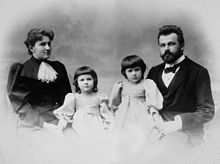Adolf Hengeler

Adolf Hengeler (born February 11, 1863 in Kempten (Allgäu) , † December 3, 1927 in Munich ) was a German painter .
Life
Personal and education
Adolf Hengeler was born in Kempten in 1863 as the son of the administrator of the Margarethen and Josephinenstiftung. The young Adolf Hengeler from Kempten moved to Munich in 1881, where he studied art and belonged to the circle of the painter Wilhelm von Diez . Hengeler became known in larger circles for his work on the flying leaves , for which he was one of the most important draftsmen for twenty years. In 1889 he married Emilia Hausinger, daughter of the Munich goldsmith and court jeweler Adam Hausinger (1820–1908), and then belonged to the wealthy circles. From 1912 Hengeler taught as a professor at the Academy of Fine Arts in Munich . His daughter Emilie (1890–1969) was the wife of the SS group leader and lieutenant general of the Ordnungspolizei , Adolf von Bomhard .
Artistic career
In 1878 Adolf Hengeler began an apprenticeship as a lithographer with Markmiller, a drawing teacher. In 1881 Hengeler entered the arts and crafts school ; Teacher Ferdinand Barth encouraged him. From 1885 he studied at the Munich Academy , first with Johann Leonhard Raab , the head of the copper engraving school, then for two years in Wilhelm von Diez's painting class.
While still a student, from 1884, Adolf Hengeler made over 5,000 drawings as one of the most zealous employees of the Fliegende Blätter .
Hengeler began painting in 1900, influenced by Franz von Lenbach , Arnold Böcklin , Carl Spitzweg and Franz von Stuck . The intensity and the relaxed force in the style that he had previously devoted to graphics, he now transferred to brush and canvas. In 1902 Hengeler became adjunct professor, in 1912 professor at the Munich Academy . Among his students were Gisbert Palmié and Fritz Wrampe .
From 1893 Hengeler was regularly involved in the exhibitions of the Munich Secession and the Great Berlin Art Exhibition , also in the exhibitions in the Munich Glass Palace (1898 ff., 1897, 1901, 1913), exhibitions in Dresden, Düsseldorf a. a.
Afterlife
For the 150th birthday of the painter and draftsman, his hometown Kempten is showing a special exhibition in the Allgäu Museum from May 9, 2013 to January 6, 2014, which is housed in the Kornhaus . On this occasion, the composer Christian Ludwig Mayer from Allgäu created the so-called Hengeler Art Revue or the strange sorrows of an art professor as a music theater performance based on personal testimonies and contemporary reports about Hengeler .
Works
The work includes applied graphics, caricatures and picture stories in an unmistakable humorous, good-natured, yet gleeful and detailed conception. Hengeler's characteristic graphics range from airy color drawings to precise ink strokes in a confident manner, which can be compared here and there with Wilhelm Busch . In addition to the regular contributions to the “Fliegende Blätter”, the “Münchner Kinderfibel” and the “Kriegstagebuch 1914/15” were well-known publications.
In painting, Hengeler concentrated on landscapes, animated by putti and mythical creatures, and idylls or people in landscapes. In ever new variations he formulated graceful scenes in the undisturbed nature of Upper Bavaria or the Allgäu, which met the taste of the audience. In later years Hengeler turned to Christian legends and characters from biblical history with which he decorated his natural scenes. The mood of the picture is often determined by earthy brown tones, which bring light local and pastel tones into the flesh , in clothing or in flowers.
The art historian Peter von Bomhard (* 1919 in Munich; † 1979 in Rosenheim) decreed in his will: “I will bequeath the entire artistic and personal estate of my grandfather Adolf Hengeler to the museum of the city of Kempten, the city of my grandfather's birth, with the request Possibility to set up a Hengeler room in the museum building, in which the few remaining pieces of furniture and other memorabilia from his apartment as well as his portraits can be displayed. "
literature
- Hengeler album , Munich (Braun & Schneider) 1904
- From a 1914/15 diary by Adolf Hengeler. Munich (Verlag Carl Schnell)
- Lorenz Maier : Hengeler, Adolf. In: Karl Bosl (ed.): Bosls Bavarian biography. Pustet, Regensburg 1983, ISBN 3-7917-0792-2 , p. 331 ( digitized version ).
- Alfred Weitnauer: cheerful visions . Kempten (publishing house for home care) 1963.
- SECESSION. The Munich Secession 1892–1914. Edited by Michael Buhrs. Publication for the exhibition The Secession is a Weltanschauung (Max Liebermann). The Munich Secession 1892–1914 , Museum Villa Stuck Munich (Edition Minerva) 2008, ISBN 978-3-938832-33-2
- Ursula Winkler (ed.): Adolf Hengeler - Munich Art Between Lenbach and Stuck (accompanying volume for the exhibition of the museums of the city of Kempten). Lindenberg i. Allgäu (Kunstverlag Josef Fink) 2013, ISBN 978-3-89870-816-6
Web links
- Literature by and about Adolf Hengeler in the catalog of the German National Library
- Adolf Hengeler in HeidICON Illustrations of the Flying Leaves
| personal data | |
|---|---|
| SURNAME | Hengeler, Adolf |
| BRIEF DESCRIPTION | German painter |
| DATE OF BIRTH | February 11, 1863 |
| PLACE OF BIRTH | Kempten (Allgäu) |
| DATE OF DEATH | December 3, 1927 |
| Place of death | Munich |


